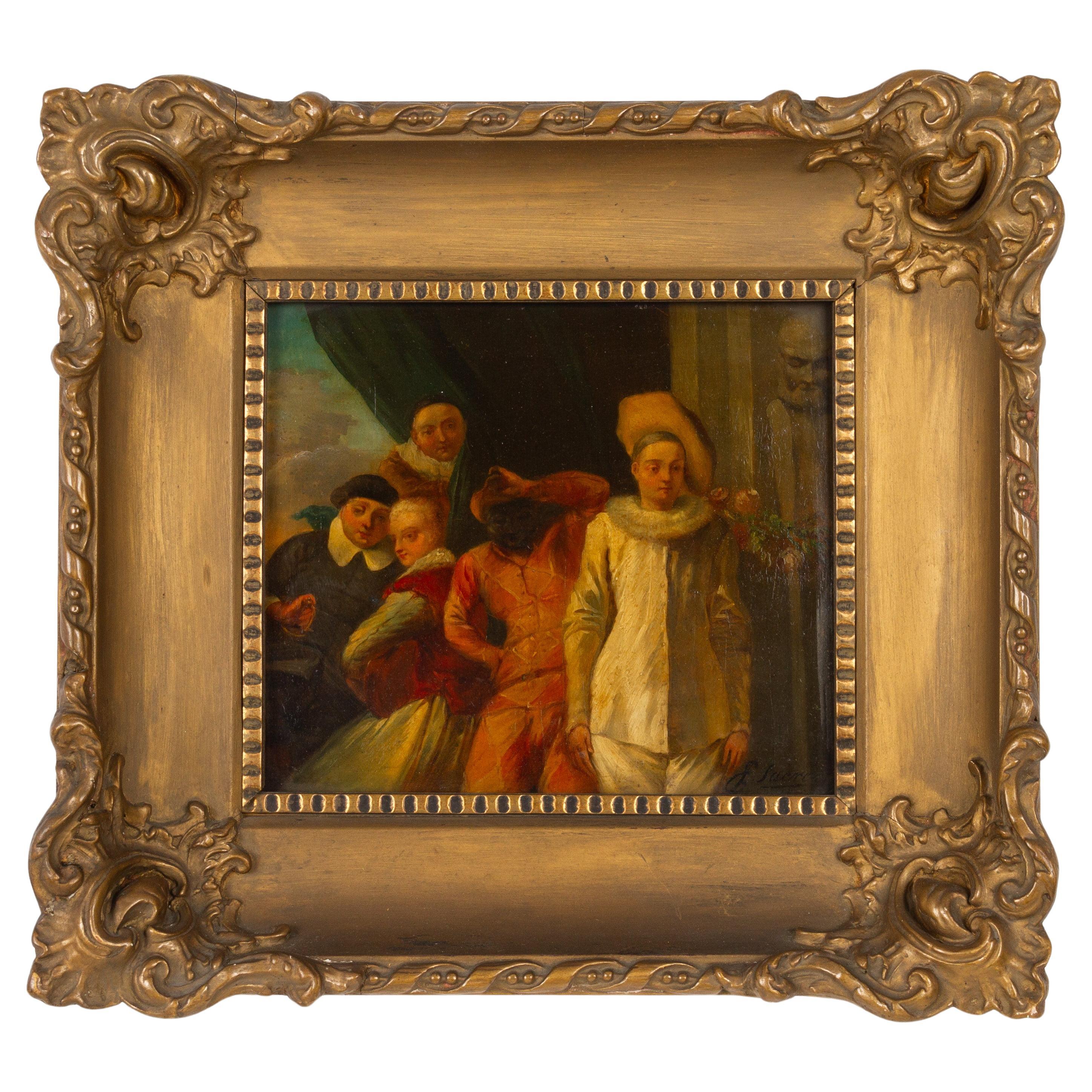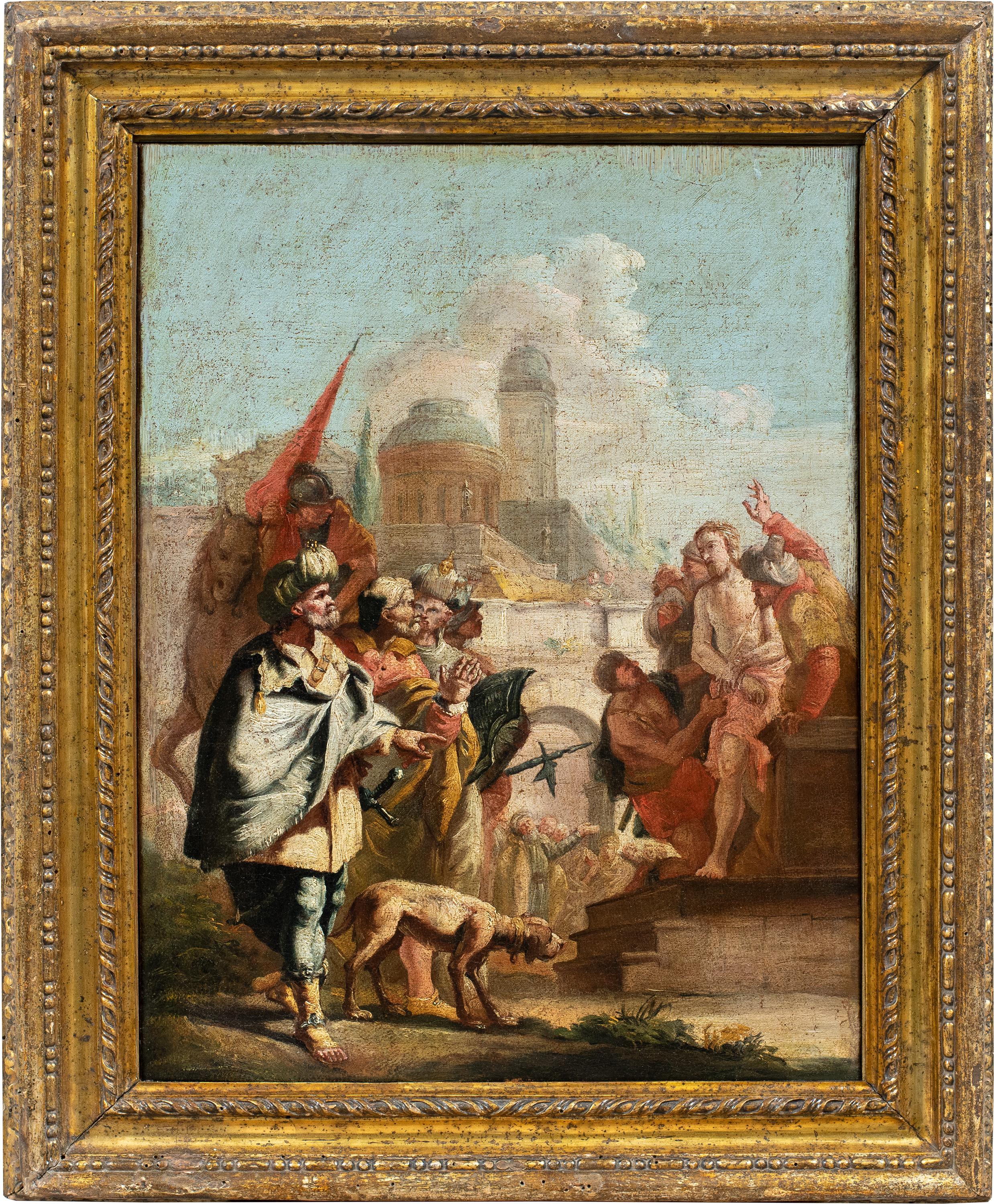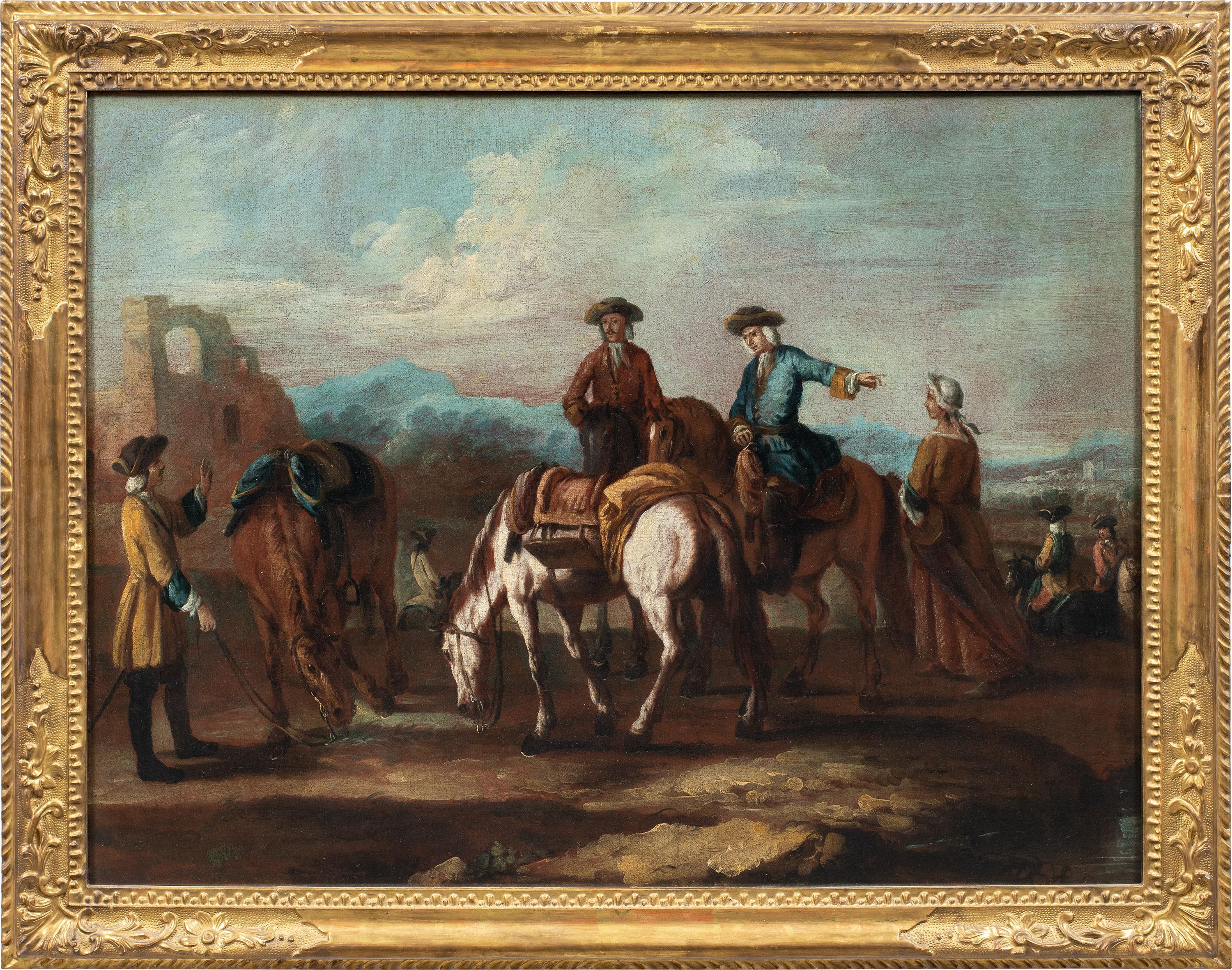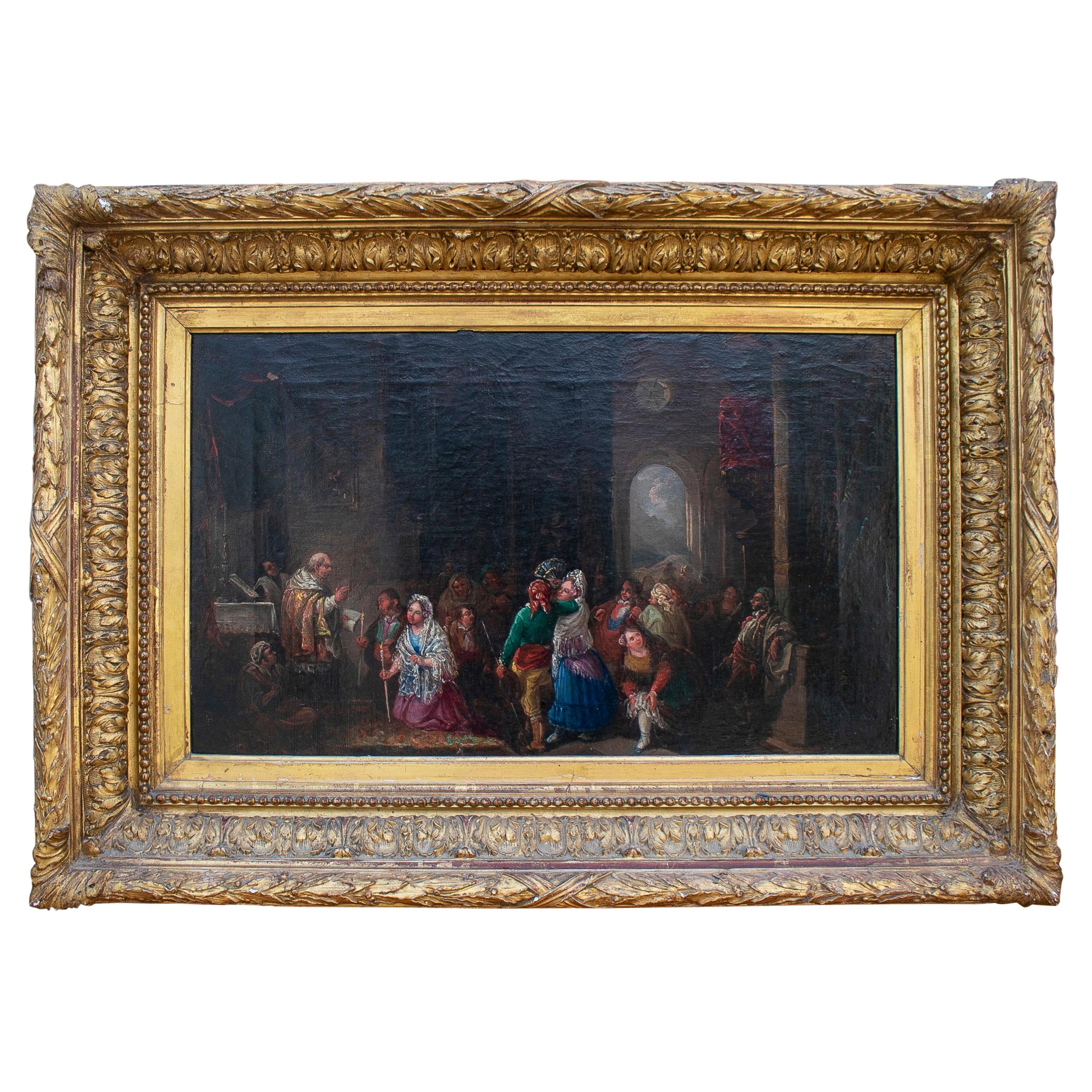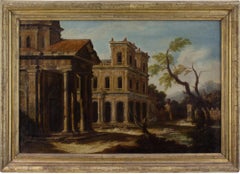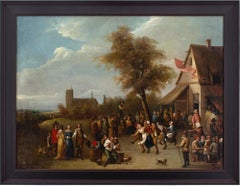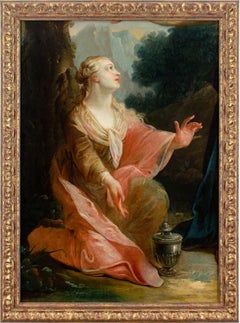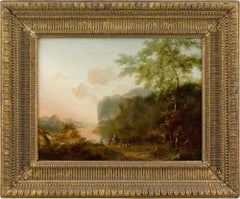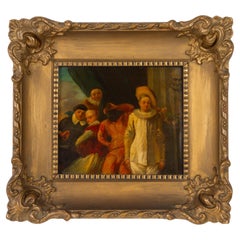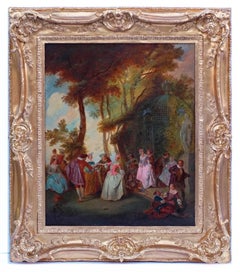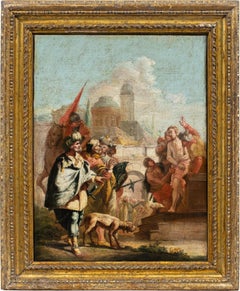Items Similar to Franz De Paula Ferg (Attributed), Figures Of The Commedia dell'Arte
Video Loading
Want more images or videos?
Request additional images or videos from the seller
1 of 15
Franz De Paula Ferg (Attributed), Figures Of The Commedia dell'Artec. 1720
c. 1720
$6,244.08
£4,510
€5,335.19
CA$8,593.88
A$9,536.19
CHF 5,030.10
MX$116,416.47
NOK 63,640.66
SEK 59,604.63
DKK 39,815.52
About the Item
This early 18th-century oil painting attributed to Austrian artist, Franz de Paula Ferg (1689-1740), depicts the Commedia dell’Arte performing in a busy Italian village square. Ferg was a distinguished painter, draughtsman and printmaker of multi-figure genre scenes and landscapes.
Amid the hurly-burly of a crowded market, citizens mingle to discuss various wares. In the foreground, a woman appears to plead with another during a goat-based debate. A behatted chap in a green coat gesticulates, perhaps bartering or explaining “we might be back later”.
By the stage, a rider atop a white horse is delayed by the crowds, as two sprightly ne'er-do-wells extract fresh eggs from his cart. Their mother stands ahead of them, awaiting the spoils. In every direction, there’s a tale unfolding. Who are these characters? What are their respective roles? Who can be trusted? From our elevated position, they appear akin to curious ‘Lilliputians’ obliviously conducting their everyday activities within a quaint miniature environment.
We’re reminded, while pondering on these intriguing questions, of the travelling actors conspicuously treading the boards on the right. The ‘Commedia dell'Arte’ was a partially improvised show based around several standard character types. Popular between the 16th and 18th centuries, actors would assume a role, such as a mischievous masked harlequin, or a self-assured ‘Il Capitano’, then proceed to amuse the audience with a string of witty shenanigans.
By including a theatre, Ferg is narrating a rather ironic story of his own, whereby the audience is providing the ‘real’ entertainment. Why do we need to concoct an imaginary story when the villagers have such stimulating tales?
“Jesters do oft prove prophets”. King Lear. William Shakespeare.
Produced during the early part of his career, the figures, colouring and overall composition are comparable with two of his signed works at the National Gallery in Prague - ‘Small Town with a Church’ and ‘Landscape with Dancing Peasants’. Also with his ‘Village on a Canal’, which is in the Lichtenstein Princely Collections. All of these stem primarily from Ferg’s tuition with Johann (Hans) Graf (1653-1710) and were probably undertaken prior to 1720.
Born in Vienna, at a time of significant change, Franz de Paula Ferg, also known by his anglicised name of Francis Paul Ferg, was a master of genre painting. He was trained initially by his father, the history painter, Adam Pankraz Ferg (1651-1729), before working first under ‘Baschueber’ and then Graf. During the early part of his career, he was particularly inspired by the latter, and developed a similar style, both in terms of brushwork and colouring. Often we see a blueish-green landscape with figures rendered consistently in ochre, tinted vermillion, and light blue. Most of his works were on small sheets of copper.
Next, Ferg lived with the landscape painter, Josef Orient (1677-1747), presumably working in his studio. Apprentices, in general, were known to assist the master with specific elements, such as adding figures (also known as ‘staffage’) into a view. Indeed, when looking across Orient’s oeuvre, it would appear that Ferg was more accomplished at rendering believable forms. There was probably a similar arrangement in place when he travelled to Dresden and worked alongside Johann Alexander Thiele (1685-1752).
It was in Dresden that Ferg established himself as an artist of considerable merit, producing numerous works for patrons. His attention to minutiae, coupled with his advanced skill as a colourist, formed the basis of a growing reputation. He soon taught himself to etch, thus enabling him to offer prints alongside his works in oil.
In his ‘Figures of the Commedia dell'Arte Performing a Quack Doctor Scene in a Village Square’, which sold at Christie’s in 2013, there’s a sense of realism, which is comparable with some of the early Dutch masters. While his ‘A Village Dance’ demonstrates his proficiency of rendering complex figure arrangements, reminiscent of the great Pieter Brueghel the Elder (1526/1530-1569).
In 1724, Ferg settled in London, where he again established a profitable relationship with local patrons. In addition to his village scenes, he also produced idealised Italianate landscapes - popular among young aristocratic males, having completed their Grand Tour.
However, despite his evident success, he fell into exceedingly dire financial and personal circumstances, which, according to the writer George Virtue, were the result of a dreadful marriage. Virtue described him as “so unhappily married to a boisterous extravagant hussy, (being a long time prisoner for debt) that she kept the man always poor and indigent”. Which “brought him so low, that being quite exhausted, he went out to some company the last evening of his life, and dropt down dead before he got home in the street”.
This version of events, however, was disputed by the art dealer Noël Desenfans (1741-1807), who attributed Ferg’s pecuniary woe to a head injury caused by a falling roof tile. We may never know the truth, but either way, it led to a pauper’s burial at the infamous Saint Giles in the Fields, Camden.
He’s represented in numerous public collections, including at The British Museum, V&A Museum, and The Met Museum in New York. Virtue described him as “a painter of an uncommon genius”.
Possibly signed in the lower right. Held in a later frame.
Provenance: Private collection, Germany.
Artist’s auction maximum: £160,000 for ‘River Landscape with Figures on a Boat, Banks and in a Ferry’, Oil on copper, Sotheby’s, Old Master Paintings - Part I, London, 12 July (lot 57).
Our reference: BRV2114
- Attributed to:Franz de Paula Ferg (1689 - 1740)
- Creation Year:c. 1720
- Dimensions:Height: 14.5 in (36.83 cm)Width: 17.5 in (44.45 cm)
- Medium:
- Period:1720-1729
- Condition:Cleaned. Fine craquelure throughout. The paint layer is stable. Frame with various marks and showing its age. Slight undulation to the copper.
- Gallery Location:Cheltenham, GB
- Reference Number:1stDibs: LU2328216314232
About the Seller
5.0
Platinum Seller
Premium sellers with a 4.7+ rating and 24-hour response times
Established in 2017
1stDibs seller since 2023
243 sales on 1stDibs
Typical response time: 1 hour
- ShippingRetrieving quote...Shipping from: Cheltenham, United Kingdom
- Return Policy
Authenticity Guarantee
In the unlikely event there’s an issue with an item’s authenticity, contact us within 1 year for a full refund. DetailsMoney-Back Guarantee
If your item is not as described, is damaged in transit, or does not arrive, contact us within 7 days for a full refund. Details24-Hour Cancellation
You have a 24-hour grace period in which to reconsider your purchase, with no questions asked.Vetted Professional Sellers
Our world-class sellers must adhere to strict standards for service and quality, maintaining the integrity of our listings.Price-Match Guarantee
If you find that a seller listed the same item for a lower price elsewhere, we’ll match it.Trusted Global Delivery
Our best-in-class carrier network provides specialized shipping options worldwide, including custom delivery.More From This Seller
View AllLate 17th-Century Italian School, Architectural Capriccio With Portico
Located in Cheltenham, GB
This late 17th-century Italian oil painting depicts a view with distinctive Italianate architecture including a building with an iconic portico and pediment.
Popular in mid-17th-cen...
Category
1680s Italian School Landscape Paintings
Materials
Oil, Canvas
David Teniers The Younger (After), Country Celebration
By David Teniers the Younger
Located in Cheltenham, GB
This charming mid-18th-century oil painting depicts a veritable array of revellers holding a feast by a tavern. It’s after a work by Flemish artist, David Teniers the Younger (1610-1...
Category
1750s Figurative Paintings
Materials
Oil, Canvas
18th-Century Venetian School, Mary Magdalene, Noli Me Tangere
Located in Cheltenham, GB
This late 18th-century Italian oil painting fragment depicts Mary Magdalene kneeling alongside an alabaster jar. Christ’s hand is partially visible above, along with his robes, which...
Category
18th Century Italian School Figurative Paintings
Materials
Oil, Canvas
Jan Both (Follower), Idyllic River Landscape With Figures
Located in Cheltenham, GB
This early 18th-century Dutch oil painting depicts figures in a picturesque backlit river landscape. It’s influenced by the works of Jan Both (1615-1652).
A falling sun casts an atm...
Category
Early 18th Century Baroque Landscape Paintings
Materials
Oil, Panel
Arturo Orselli, The Flirtatious Huntsman
By Arturo Orselli
Located in Cheltenham, GB
This charming late 19th-century oil painting by Arturo Orselli (fl. 1880-1896) depicts a huntsman wearing riding gear conversing somewhat flirtatiously with two ladies.
Attired in o...
Category
1890s Figurative Paintings
Materials
Oil, Canvas
Hermann Weiß, Consequences Of The Game
Located in Cheltenham, GB
This mid-19th-century oil painting by German artist Hermann Weiß (1822-1897) depicts a musketeer lying upon the floor of a 17th-century interior, following an eventful game of cards....
Category
Mid-19th Century Victorian Figurative Paintings
Materials
Oil, Canvas
You May Also Like
Emile Sacre (Belgian, 1844-1882) Oil Painting Commedia Dell'arte 19thC
Located in Nottingham, GB
In good condition
From a private collection
Free international shipping
Emile Sacre (Belgian, 1844-1882) Oil Painting Commedia Dell'arte 19thC
Category
Antique 19th Century Paintings
Materials
Wood, Paint
Travelling Comic Theatre - Italian 18thC art figurative landscape oil painting
By Marco Marcola
Located in London, GB
This interesting Italian 18th century Old Master oil painting is by noted artist Marco Marcola, also known as Marco Marcuola. It was painted circa 1770 and has excellent provenance. ...
Category
1770s Old Masters Figurative Paintings
Materials
Oil
Painting 19th Century Romantic Courtiers Genre Scene
Located in Saint-Ouen, FR
Courtiers Party in the Park in 18th Century
In the Taste of Nicolas Lancret (1690-1743)
Oil on canvas
Frame gilded with leaves
Dim canvas : 73 X 59 cm
Dim frame : 100 X 87 cm
Category
1850s Old Masters Portrait Paintings
Materials
Oil
Rococò Venetian painter - 18th century figure painting - Christ led to judgment
Located in Varmo, IT
Venetian painter (18th century) - Christ led to judgment (preparatory sketch).
48 x 36 cm without frame, 62 x 50.5 cm with frame.
Antique oil painting on canvas, in a carved and gi...
Category
Mid-18th Century Rococo Figurative Paintings
Materials
Canvas, Oil
$2,387 Sale Price
42% Off
Giuseppe Zais (Venetian master) - 18th century landscape painting - Knights
By Giuseppe Zais (Canale d'Agordo, Belluno 1709 - Treviso 1781)
Located in Varmo, IT
Giuseppe Zais (Forno di Canale 1709 - Treviso 1784) - Landscape with Resting Horsemen.
55.5 x 85.5 cm unframed, 78 x 98.5 cm with frame.
Oil on canvas, in a carved and gilded woode...
Category
Mid-18th Century Rococo Landscape Paintings
Materials
Canvas, Oil
19th Century Oil on Canvas Painting Attributed to Eugenio Lucas Villamamil
Located in Marbella, ES
Antique 19th century oil on canvas people painting attributed to Eugenio Lucas Villamamil, with acanthus and foliate gilt wood and gesso frame
Dimensi...
Category
Antique 19th Century Spanish Paintings
Materials
Canvas
